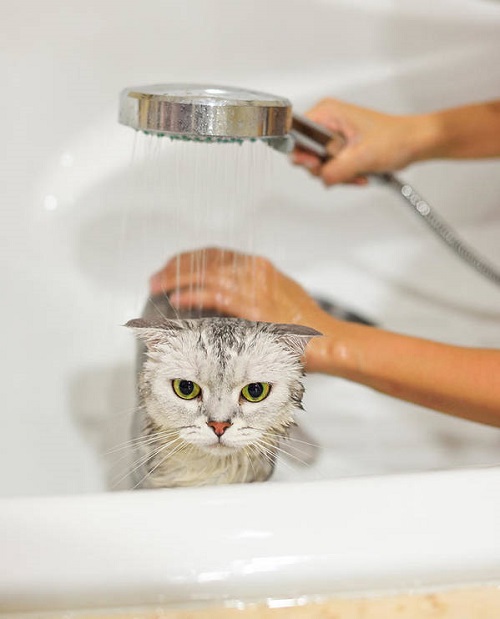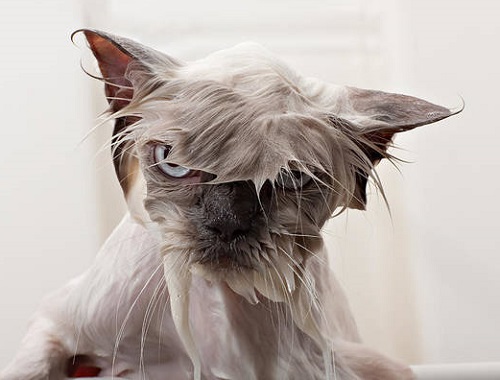Do Cats Need Shower despite their meticulous grooming habits? Let’s find out the answer and much more in this article!
Cats spend hours licking and cleaning themselves. However, as a pet parent, you might wonder if they need more than just self-cleaning. More specifically, your question might be – Do Cats Need Shower? Scroll to find out the truth.
Do Ragdoll Cats Like Water? Find out here
The Natural Grooming Habits Of Cats

Cats are inherently finicky creatures and possess natural grooming habits that play a significant role in their overall well-being. From the time they are kittens, felines develop a grooming routine that becomes an integral part of their daily lives. Their unique grooming behavior serves both practical and social purposes.
- Hygiene: One of the primary reasons cats groom themselves is to keep their fur clean and free of dirt and parasites. They use their tongues, which are covered in tiny barbs, to remove debris and untangle their fur. Through this process, kitties also ingest loose hair, which forms hairballs that are later eliminated through the digestive system.
- Body temperature regulation: Grooming helps to regulate a cat’s body temperature. When a cat licks its fur, the saliva evaporates and cools the skin, providing relief in hot weather. Conversely, during colder months, grooming helps to distribute the natural oils produced by the skin, which acts as an insulating layer.
- Social activity: Beyond practical purposes, grooming is also a social behavior among cats. Mutual grooming, known as allogrooming, is a bonding activity that strengthens social ties within a group of cats. It is a way for kitties to establish and maintain social harmony, demonstrate affection, and engage in social communication.
Observing a cat’s grooming habits can provide valuable insights into their overall health. Changes in grooming behavior, such as excessive grooming or neglecting grooming altogether, may be indicative of underlying health issues or stress. It is important for cat owners to be aware of their pet’s grooming patterns and seek veterinary attention if any significant changes are noticed.
Do Cats Need Shower?

So, do cats need to shower? The answer is not a straight ‘yes’ or ‘no.’ As discussed above, cats are self-sufficient when it comes to cleaning and grooming their bodies. However, there are certain circumstances where a bath may be necessary. For instance, if a cat gets into something particularly dirty or smelly, a bath might be necessary to remove the substance from its fur. Additionally, some cats with certain medical conditions or allergies may require regular bathing as part of their treatment.
How To Give Your Cat a Bath?
Bathing a cat is not an easy job. However, with patience and a gentle approach, you can successfully give your kitty a bath. Here is how to give your feline a bath:
- Prepare the bathing area: Choose a small room, such as a bathroom, where your cat can feel secure. Place a rubber mat or towel in the bottom of the sink or tub to prevent slipping.
- Gather necessary supplies: Have all the supplies you need within reach, including cat-friendly shampoo, a pitcher, or handheld sprayer for water, towels, and treats.
- Start with grooming: Before the bath, brush your cat’s fur to remove any tangles or loose hair. This will make the bathing process smoother and help prevent matting.
- Gradually introduce water: Fill the sink or tub with a few inches of lukewarm water. Test the water temperature with your hand to ensure it is not too hot or too cold. Begin by gently wetting your cat’s body using a pitcher or a handheld sprayer. Avoid spraying water directly on their face.
- Use cat-friendly shampoo: Apply a small amount of cat-specific shampoo to your hands and lather it gently into your cat’s fur. Be careful to avoid their eyes, ears, and nose. Work the shampoo into a gentle massage, focusing on areas that may be particularly dirty. Avoid using human shampoos or harsh chemicals, as they can cause skin irritation.
- Rinse thoroughly: Rinse your cat’s fur thoroughly using lukewarm water. Ensure that there is no shampoo residue left on their skin, as it can cause irritation.
- Towel-dry your cat: After rinsing, lift your cat out of the water and place them on a towel. Gently wrap the towel around them and pat dry. Avoid vigorously rubbing, as it can cause discomfort.
Remember, not all cats will tolerate or require regular baths. If your cat becomes extremely stressed or agitated during the bathing process, seek professional grooming assistance or consult with a veterinarian.
Tips For Bathing A Reluctant Cat
Bathing a reluctant cat can be a daunting task, but with the right approach and some helpful tips, you can make the experience more manageable for you and your kitty. Here are some strategies to overcome challenges and make bathing a reluctant cat a bit easier:
- Gradual introduction: Start by gradually introducing your cat to the bathing process. Begin with short sessions where you simply let them explore an empty tub or sink. Reward them with treats and praise to create positive associations.
- Use a calm and confident approach: Cats can sense your energy, so remain calm and confident during the bathing process. Speak in soothing tones and maintain a composed demeanor to keep your cat at ease.
- Warm water and gentle handling: Use lukewarm water for the bath and avoid spraying water directly on your cat’s face. Be gentle when handling your cat, ensuring you support its body and keep its head elevated to prevent water from entering its ears.
- Quick and efficient: Keep the bathing process as brief as possible. Work efficiently but gently to minimize stress for your cat. Focus on areas that require cleaning the most and avoid overwashing.
- Towel-wrap method: After the bath, wrap your cat snugly in a towel to keep it warm and secure. This makes your furry companion feel safe and reduces the chances of them trying to escape or scratch.
- Patience and positive reinforcement: Be patient and understanding throughout the process. Offer praise, treats, and gentle strokes to reward your cat for cooperation. Positive reinforcement helps create positive associations with bathing.
Do Cats Need Shower? Quick Takeaways
- Cats groom themselves to maintain cleanliness and remove dirt and parasites.
- Grooming helps regulate a cat’s body temperature, keeping them cool in hot weather and warm in cold weather.
- Grooming is also a social behavior among cats, strengthening social bonds and communication.
- Cats may not need frequent baths due to their natural grooming abilities.
- Circumstances that may warrant a bath include getting into something dirty or smelly or having certain medical conditions or allergies.
- When giving your kitty a bath, prepare a secure bathing area and gather the necessary supplies.
- Begin by grooming the cat’s fur before introducing water gradually.
- Use cat-friendly shampoo and rinse thoroughly to avoid skin irritation.
- Towel-dry the cat gently and provide comfort and rewards after the bath.
- If your cat resists bathing, introduce the process gradually, and remain calm and confident.



